
The House of Hohenzollern is a formerly royal German dynasty whose members were variously princes, electors, kings and emperors of Hohenzollern, Brandenburg, Prussia, the German Empire, and Romania. The family came from the area around the town of Hechingen in Swabia during the late 11th century and took their name from Hohenzollern Castle. The first ancestors of the Hohenzollerns were mentioned in 1061.

Crown jewels are the objects of metalwork and jewellery in the regalia of a current or former monarchy. They are often used for the coronation of a monarch and a few other ceremonial occasions. A monarch may often be shown wearing them in portraits, as they symbolize the power and continuity of the monarchy. Additions to them may be made, but since medieval times the existing items are typically passed down unchanged as they symbolize the continuity of the monarchy.

A crown is a traditional form of head adornment, or hat, worn by monarchs as a symbol of their power and dignity. A crown is often, by extension, a symbol of the monarch's government or items endorsed by it. The word itself is used, particularly in Commonwealth countries, as an abstract name for the monarchy itself, as distinct from the individual who inhabits it. A specific type of crown is employed in heraldry under strict rules. Indeed, some monarchies never had a physical crown, just a heraldic representation, as in the constitutional kingdom of Belgium.

The Crown Jewels of the United Kingdom, originally the Crown Jewels of England, are a collection of royal ceremonial objects kept in the Tower of London, which include the coronation regalia and vestments worn by British monarchs.
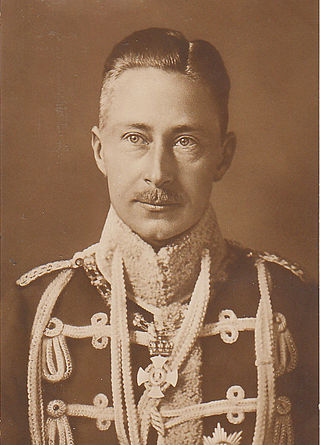
Wilhelm, German Crown Prince, Crown Prince of Prussia was the eldest child of the last Kaiser, Wilhelm II, German Emperor, and his consort Augusta Victoria of Schleswig-Holstein, and thus a great-grandson of Queen Victoria, and distant cousin to many British Royals, such as Queen Elizabeth ll. As Emperor Wilhelm's heir, he was the last Crown Prince of the German Empire and the Kingdom of Prussia, until the abolition of the monarchy.

Danish Crown Regalia are the symbols of the Danish monarchy. They consist of three crowns, a Sceptre, Globus cruciger, the Sword of state and an Ampulla . The Danish Royal Regalia are kept in the treasury at Rosenborg Castle. The oldest of these is Christian III's sword of state from 1551. They further include King Christian IV's diamond; pearl- and gold-embroidered saddles; objects carved from ivory and rock-crystal; lapidary pieces of precious stones, and brooches in the form of fantastic animals.

The Order of the Black Eagle was the highest order of chivalry in the Kingdom of Prussia. The order was founded on 17 January 1701 by Elector Friedrich III of Brandenburg. In his Dutch exile after World War I, deposed Emperor Wilhelm II continued to award the order to his family. He made his second wife, Princess Hermine Reuss of Greiz, a Lady in the Order of the Black Eagle.

The Imperial crown of Russia, also known as the great imperial crown, was used for the coronation of the monarchs of Russia from 1762 until the Russian monarchy's abolition in 1917. The great imperial crown was first used in the coronation by Catherine the Great, and it was last worn at the coronation of Nicholas II. It was displayed prominently next to Nicholas II on a cushion at the State Opening of the Russian Duma inside the Winter Palace in St. Petersburg in 1906. It survived the 1917 revolution and is currently on display in Moscow at the Kremlin Armoury's State Diamond Fund.

The Crown of Queen Mary is a consort crown that was made in 1911 for the coronation of British queen Mary of Teck. Mary thereafter wore it on occasion in circlet form. It is part of the Crown Jewels of the United Kingdom. It was used again, in a slightly altered form, at the coronation of Queen Camilla on 6 May 2023.

Cecilienhof Palace is a palace in Potsdam, Brandenburg, Germany, built from 1914 to 1917 in the layout of an English Tudor manor house. Cecilienhof was the last palace built by the House of Hohenzollern that ruled the Kingdom of Prussia and the German Empire until the end of World War I. It is famous for having been the location of the Potsdam Conference in 1945, in which the leaders of the Soviet Union, the United Kingdom and the United States made important decisions affecting the shape of post World War II Europe and Asia. Cecilienhof has been part of the Palaces and Parks of Potsdam and Berlin UNESCO World Heritage Site since 1990.
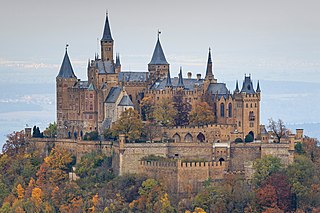
Hohenzollern Castle is the ancestral seat of the imperial House of Hohenzollern. The third of three hilltop castles built on the site, it is located atop Mount Hohenzollern, above and south of Hechingen, on the edge of the Swabian Jura of central Baden-Württemberg, Germany.

The Antique Temple is a small round temple in the west part of Sanssouci Park in Potsdam. Frederick the Great had the building constructed to house his collection of classical works of art, antique artifacts, coins and antique gems. Carl von Gontard created the building in 1768/69 near the New Palace north of the Central Alley, as a complement to the Temple of Friendship situated south of the Alley. Since 1921 the Antique Temple has been used as a mausoleum for members of the House of Hohenzollern and is not open to the public.

Duchess Cecilie Auguste Marie of Mecklenburg-Schwerin was the last German Crown Princess and Crown Princess of Prussia as the wife of Wilhelm, German Crown Prince, the son of German Emperor Wilhelm II.

The Hohenzollern Bridge is a bridge crossing the river Rhine in the German city of Cologne. It crosses the Rhine at kilometre 688.5. Originally, the bridge was both a railway and road bridge. However, after its destruction in 1945 and its subsequent reconstruction, it was only accessible to rail and pedestrian traffic.
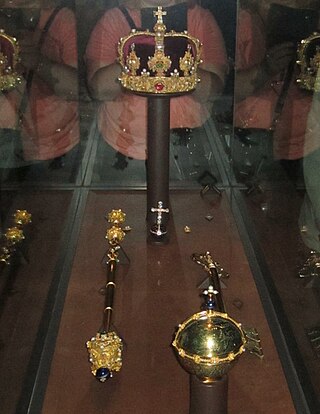
Sweden's regalia are kept deep in the vaults of the Royal Treasury, underneath the Royal Palace in Stockholm, in a museum that is open to the public. The crowns and coronets have not been worn by Swedish royalty since 1907, but they are still displayed at weddings, christenings and funerals.

The Crown Jewels of Württemberg are a historical jewel collection belonging to the Kings and Queens of Württemberg.
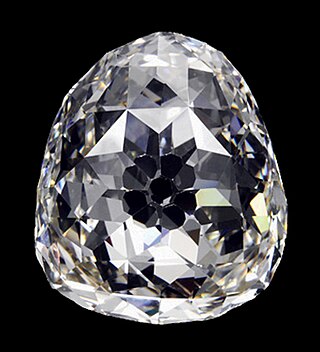
The Beau Sancy is a 34.98-carat diamond originally mined in India, which is cut in a modified pear double rose-cut shape. Since appearing in Europe in the 16th century, the Beau Sancy has been owned by a number of European royal houses, among them the House of Medici and the kings of England and Prussia. After more than 300 years in the possession of the House of Hohenzollern, the diamond was sold in 2012 at Sotheby's auction in Geneva for $9.57 million to an anonymous buyer.

Crown of Baden, also known as the Grand Ducal Crown of Baden is a crown formerly used by the Grand Duke of Baden and part of the Crown Jewels of Baden. The crown is 26 cm high and has a diameter of 13,8 cm. Today the crown is kept at the Museum of Baden, which itself was built within the old walls of the former Karlsruhe Palace.

The abdication of Wilhelm II as German Emperor and King of Prussia was declared by Chancellor Maximilian of Baden on 9 November 1918; it was formally affirmed by a written statement of Wilhelm on 28 November, made while in exile in Amerongen, the Netherlands. The abdication caused the German Empire to dissolve and concluded the House of Hohenzollern's 500-year rule over Prussia and its predecessor state, Brandenburg. Wilhelm reigned from 15 June 1888 to 9 November 1918. As a result of the abdication and the German Revolution of 1918–19, the nobility as a legally-defined class was abolished. Following the proclamation of the Weimar Constitution on 11 August 1919, all Germans were declared equal before the law. The rulers of the twenty-two constituent states of the Empire also had to relinquish their monarchical titles and domains.
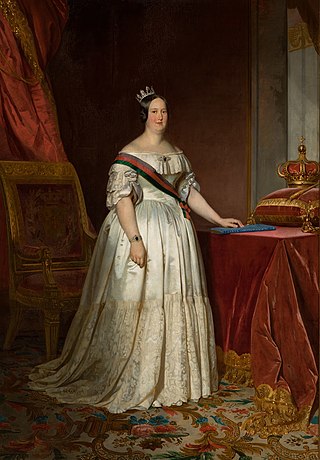
The Tiara of Maria II is a jewelled, ornamental crown made for Queen Maria II of Portugal in the 1830s-40s, set in sapphires and diamonds. It is the oldest extant tiara that can be linked to a Portuguese sovereign.




















